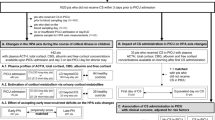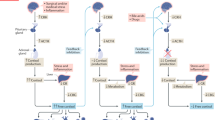Abstract
Context
Changes in cortisol metabolism due to altered activity of the enzyme 11β-hydroxysteroid dehydrogenase (11β-HSD) have been implicated in the pathogenesis of hypertension, obesity and the metabolic syndrome. No published data exist on the activity of this enzyme in critical illness.
Objective
To investigate cortisol metabolism in critically ill patients utilising plasma cortisol: cortisone ratio as an index of 11β-HSD activity.
Setting
Tertiary level intensive care unit.
Patients
Three cohorts of critically ill patients: sepsis (n = 13); multitrauma (n = 20); and burns (n = 19).
Main outcome measures
Serial plasma cortisol: cortisone ratios.
Measurements and main results
Plasma total cortisol cortisone ratios were determined serially after admission to the intensive care unit. As compared with controls, the plasma cortisol:cortisone ratio was significantly elevated in the sepsis and trauma cohorts on day 1 (22 ± 9, p = 0.01, and 23 ± 19, p = 0.0003, respectively) and remained elevated over the study period. Such a relationship was not demonstrable in burns. The ratio was significantly correlated with APACHE II (r = 0.77, p = 0.0008) and Simplified Acute Physiology Score (r = 0.7, p = 0.003) only on day 7 and only in the burns cohort. There were no significant correlations observed between total plasma cortisol or cortisone and sickness severity in the sepsis and trauma cohorts.
Conclusions
In critically ill patients, there is evidence of altered cortisol metabolism due to an increase in 11β-HSD activity as demonstrated by an elevation of plasma cortisol: cortisone ratios. Further studies with larger sample sizes specifically designed to examine altered tissue 11β-HSD activity and its clinical significance and correlation with outcome are warranted.

Similar content being viewed by others
References
Bouachour G, Tirot P, Gouello JP, Mathieu E, Vincent JF, Alquier P (1995) Adrenocortical function during septic shock. Intensive Care Med 21:57–62
Hinshaw LB, Beller BK, Chang AC, Murray CK, Flournoy DJ, Passey RB, Archer LT (1985) Corticosteroid/antibiotic treatment of adrenalectomized dogs challenged with lethal E. coli. Circ Shock 16:265–277
Venkatesh B, Mortimer RH, Couchman B, Hall J (2005) Evaluation of random plasma cortisol and the low dose corticotropin test as indicators of adrenal secretory capacity in critically ill patients: a prospective study. Anaesth Intensive Care 33:201–209
Schein RM, Sprung CL, Marcial E, Napolitano L, Chernow B (1990) Plasma cortisol levels in patients with septic shock. Crit Care Med 18:259–263
Annane D, Sebille V, Troche G, Raphael JC, Gajdos P, Bellissant E (2000) A 3-level prognostic classification in septic shock based on cortisol levels and cortisol response to corticotropin. J Am Med Assoc 283:1038–1045
Aygen B, Inan M, Doganay M, Kelestimur F (1997) Adrenal functions in patients with sepsis. Exp Clin Endocrinol Diabetes 105:182–186
Barquist E, Kirton O (1997). Adrenal insufficiency in the surgical intensive care unit patient. J Trauma 42:27–31
Marik PE, Zaloga GP (2002) Adrenal insufficiency in the critically ill: a new look at an old problem. Chest 122:1784–1796
Rothwell PM, Udwadia ZF, Lawler PG (1991) Cortisol response to corticotropin and survival in septic shock. Lancet 337:582–583
Sibbald WJ, Short A, Cohen MP, Wilson RF (1977) Variations in adrenocortical responsiveness during severe bacterial infections. Unrecognized adrenocortical insufficiency in severe bacterial infections. Ann Surg 186:29–33
Yildiz O, Doganay M, Aygen B, Guven M, Keleutimur F, Tutuu A (2002). Physiological-dose steroid therapy in sepsis [ISRCTN36253388]. Crit Care 6:251–259
Marik PE, Zaloga GP (2003) Adrenal insufficiency during septic shock. Crit Care Med 31:141–145
Dickstein G, Shechner C, Nicholson WE, Rosner I, Shen-Orr Z, Adawi F, Lahav M (1991). Adrenocorticotropin stimulation test: effects of basal cortisol level, time of day, and suggested new sensitive low dose test. J Clin Endocrinol Metab 72:773–778
Cohen J, Venkatesh B, Galligan J, Thomas P (2004) Salivary cortisol concentration in the intensive care population: correlation with plasma cortisol values. Anaesth Intensive Care 32:843–845
Hamrahian AH, Oseni TS, Arafah BM (2004). Measurements of serum free cortisol in critically ill patients. N Engl J Med 350:1629–1638
Ho JT, Al-Musalhi H, Chapman MJ, Quach T, Thomas PD, Bagley CJ, Lewis JG, Torpy DJ (2006). Septic shock and sepsis: a comparison of total and free plasma cortisol levels. J Clin Endocrinol Metab 91:105–114
Tomlinson JW, Stewart PM (2001) Cortisol metabolism and the role of 11β-hydroxysteroid dehydrogenase. Best Pract Res Clin Endocrinol Metab 15:61–78
Walker EA, Stewart PM (2003). 11β-hydroxysteroid dehydrogenase: unexpected connections. Trends Endocrinol Metab 14:334–339
Morita H, Isomura Y, Mune T, Daido H, Takami R, Yamakita N, Ishizuka T, Takeda N, Yasuda K, Gomez-Sanchez CE (2004) Plasma cortisol and cortisone concentrations in normal subjects and patients with adrenocortical disorders. Metabolism 53:89–94
Morineau G, Boudi A, Barka A, Gourmelen M, Degeilh F, Hardy N, al-Halnak A, Soliman H, Gosling JP, Julien R, Brerault JL, Boudou P, Aubert P, Villette JM, Pruna A, Galons H, Fiet J (1997) Radioimmunoassay of cortisone in serum, urine, and saliva to assess the status of the cortisol-cortisone shuttle. Clin Chem 43:1397–1407
Quinkler M, Zehnder D, Lepenies J, Petrelli MD, Moore JS, Hughes SV, Cockwell P, Hewison M, Stewart PM (2005) Expression of renal 11β-hydroxysteroid dehydrogenase type 2 is decreased in patients with impaired renal function. Eur J Endocrinol 153:291–299
Duclos M, Marquez Pereira P, Barat P, Gatta B, Roger P (2005) Increased cortisol bioavailability, abdominal obesity, and the metabolic syndrome in obese women. Obes Res 13:1157–1166
Mariniello B, Ronconi V, Sardu C, Pagliericcio A, Galletti F, Strazzullo P, Palermo M, Boscaro M, Stewart PM, Mantero F, Giacchetti G (2005). Analysis of the 11β-hydroxysteroid dehydrogenase type 2 gene (HSD11B2) in human essential hypertension. Am J Hypertens 18:1091–1098
McWhinney BC, Ward G, Hickman PE (1996) Improved HPLC method for simultaneous analysis of cortisol, 11-deoxycortisol, prednisolone, methylprednisolone, and dexamethasone in serum and urine. Clin Chem 42:979–981
Kushnir MM, Neilson R, Roberts WL, Rockwood AL (2004) Cortisol and cortisone analysis in serum and plasma by atmospheric pressure photoionization tandem mass spectrometry. Clin Biochem 37:357–362
Strieter RM, Kunkel SL, Bone RC (1993) Role of tumor necrosis factor-alpha in disease states and inflammation. Crit Care Med 21:S447–S463
Cooper MS, Bujalska I, Rabbitt E, Walker EA, Bland R, Sheppard MC, Hewison M, Stewart PM (2001) Modulation of 11β-hydroxysteroid dehydrogenase isozymes by proinflammatory cytokines in osteoblasts: an autocrine switch from glucocorticoid inactivation to activation. J Bone Miner Res 16:1037–1044
Heiniger CD, Rochat MK, Frey FJ, Frey BM (2001) TNF-alpha enhances intracellular glucocorticoid availability. FEBS Lett 507:351–356
Cai TQ, Wong B, Mundt SS, Thieringer R, Wright SD, Hermanowski-Vosatka A (2001) Induction of 11β-hydroxysteroid dehydrogenase type 1 but not-2 in human aortic smooth muscle cells by inflammatory stimuli. J Steroid Biochem Mol Biol 77:117–122
Suzuki S, Tsubochi H, Ishibashi H, Matsuda Y, Suzuki T, Krozowski ZS, Sasano H, Kondo T (2005) Inflammatory mediators down-regulate 11β-hydroxysteroid dehydrogenase type 2 in a human lung epithelial cell line BEAS-2B and the rat lung. Tohoku J Exp Med 207:293–301
Tomlinson JW, Moore J, Cooper MS, Bujalska I, Shahmanesh M, Burt C, Strain A, Hewison M, Stewart PM (2001) Regulation of expression of 11β-hydroxysteroid dehydrogenase type 1 in adipose tissue: tissue-specific induction by cytokines. Endocrinology 142:1982–1989
Vogeser M, Zachoval R, Felbinger TW, Jacob K (2002) Increased ratio of serum cortisol to cortisone in acute-phase response. Hormone Res 58:172–175
Vogeser M, Groetzner J, Kupper C, Briegel J (2003) The serum cortisol:cortisone ratio in the postoperative acute-phase response. Hormone Res 59:293–296
Hobson KG, Havel PJ, McMurtry AL, Lawless MB, Palmieri TL, Greenhalgh DD (2004) Circulating leptin and cortisol after burn injury: loss of diurnal pattern. J Burn Care Rehabil 25:491–499
Draper N, Stewart PM (2005) 11β-hydroxysteroid dehydrogenase and the pre-receptor regulation of corticosteroid hormone action. J Endocrinol 186:251–271
Bernier J, Jobin N, Emptoz-Bonneton A, Pugeat MM, Garrel DR (1998) Decreased corticosteroid-binding globulin in burn patients: relationship with interleukin-6 and fat in nutritional support. Crit Care Med 26:452–460
Hewitt KN, Walker EA, Stewart PM (2005) Minireview: hexose-6-phosphate dehydrogenase and redox control of 11β-hydroxysteroid dehydrogenase type 1 activity. Endocrinology 146:2539–2543
Victor VM, Rocha M, Fuente M de la (2004) Immune cells: free radicals and antioxidants in sepsis. Int Immunopharmacol 4:327–347
Ritter C, Andrades M, Guerreiro M, Zavaschi L, Gelain DP, Souza LF, Ribeiro CA, Clausell N, Menna-Barreto S, Moreira JC, Dal-Pizzol F (2003) Plasma oxidative parameters and mortality in patients with severe burn injury. Intensive Care Med 29:1380–1383
Rauz S, Walker EA, Shackleton CH, Hewison M, Murray PI, Stewart PM (2001) Expression and putative role of 11β-hydroxysteroid dehydrogenase isozymes within the human eye. Invest Ophthalmol Vis Sci 42:2037–2042
Tomlinson JW, Sherlock M, Hughes B, Hughes SV, Kilvington F, Bartlett W, Courtney R, Rejto P, Carley W, Stewart PM (2007) Inhibition of 11β-HSD1 activity in vivo limits glucocorticoid exposure to human adipose tissue and decreases lipolysis. J Clin Endocrinol Metab 2007 [Epub ahead of print]
Bollaert PE, Charpentier C, Levy B, Debouverie M, Audibert G, Larcan A (1998) Reversal of late septic shock with supraphysiologic doses of hydrocortisone. Crit Care Med 26:645–650
van den Berghe G, Wouters P, Weekers F, Verwaest C, Bruyninckx F, Schetz M, Vlasselaers D, Ferdinande P, Lauwers P, Bouillon R (2001) Intensive insulin therapy in the critically ill patients. N Engl J Med 345:1359–1367
Kotelevtsev Y, Holmes MC, Burchell A, Houston PM, Schmoll D, Jamieson P, Best R, Brown R, Edwards CR, Seckl JR, Mullins JJ (1997) 11β-hydroxysteroid dehydrogenase type 1 knockout mice show attenuated glucocorticoid-inducible responses and resist hyperglycemia on obesity or stress. Proc Natl Acad Sci USA 94:14924–14929
Nomura S, Fujitaka M, Sakura N, Ueda K (1997) Circadian rhythms in plasma cortisone and cortisol and the cortisone/cortisol ratio. Clin Chim Acta 266:83–91
Jerjes WK, Cleare AJ, Wessely S, Wood PJ, Taylor NF (2005) Diurnal patterns of salivary cortisol and cortisone output in chronic fatigue syndrome. J Affect Disord 87:299–304
Acknowledgements
This study was supported by grants from the Princess Alexandra Hospital Research Foundation and Australia and New Zealand College of Anaesthetists.
Author information
Authors and Affiliations
Corresponding author
Rights and permissions
About this article
Cite this article
Venkatesh, B., Cohen, J., Hickman, I. et al. Evidence of altered cortisol metabolism in critically ill patients: a prospective study. Intensive Care Med 33, 1746–1753 (2007). https://doi.org/10.1007/s00134-007-0727-7
Received:
Accepted:
Published:
Issue Date:
DOI: https://doi.org/10.1007/s00134-007-0727-7




